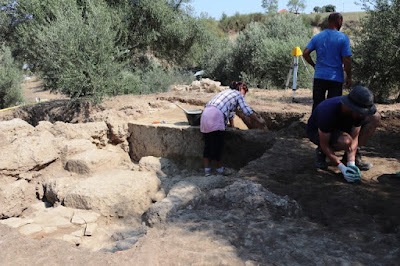A joint team of Albanian and German archaeologists have been
carrying out excavations at the village of Babunjë, Lushnjë, at a site
identified with the ancient city of Arnisa, mentioned in the Geography of
Ptolemy (written in the 2nd century CE). The site was suggested as
Arnisa in the 1940s by the Italian archaeologist P.C Sestieri, and first excavated
in the 1950s by Selim Islami and in the 80s by Perikli Çuko.
 |
| Fragmente fortifikimi në Babunjë, Lushnjë | Foto : Gëzim Kabashi |
Professor Bashkim Lahi believes that the city, which covered
an area of five to six hectares, was founded by settlers from nearby Apollonia
around the beginning of the 6th century BCE. The location was chosen
for its excellent terrain for both livestock and agriculture, and also its proximity
to the Seman river.
Situated on a low hill between Divjaka and Lushnja, the
settlement was surrounded by a defensive wall. Geophysical surveys have revealed
a well-planned city built to a grid plan. The 2019 team have excavated an area which
includes a section of road and the remains of a dwelling. The city had a main
road running through it and smaller roads branching off it at right angles, with
dwellings in blocks known as ‘insulae’.
 |
| Photo: BalkanWeb |
Pottery found in the excavations shows links with the
Mediterranean world, including trade across the Adriatic and the Ionian seas attested
by amphorae. The ceramics show strong contacts with Corinth, particularly in
the early period of the city, later on Attic imports are attested. Analysis of
the pottery may point to the town being settled by Greek colonists – Professor Lahi
suggests that the settlement may be a kind of satellite of Apollonia. Based on
the ceramics, Manuel Fiedler suggests a chronology for the settlement as founded
in the 6th century, flourished in the 5th and 4th
centuries, and then abandoned in the 3rd century BCE.
It seems that the town was prosperous and the people lived
well. Finds from previous excavations included small bronze objects, including
fibulae and weapon fragments. However, during the 2018 excavations led by
Albanian archaeologist Eduard Shehi, the team discovered a fine small bronze of
a rider on horseback, circa 14.5 centimetres high, as yet unpublished, but
thought to date to the early phase of the city.
 |
| Photo: Humboldt-Universität zu Berlin |
Shehi’s team also uncovered a well-preserved section of the fortification wall, 3 metres deep made with large, carefully cut blocks of stone. Çuko’s excavations in the 1980s had reported on the quality of the city wall, the blocks of which are cut so exactly that they fit together perfectly without the need for mortar, just as seen on other Illyrian sites throughout Albania.
The vast majority of the settlement remains unexcavated, and
Professor Lahi has highlighted the need for resources in order to continue the
excavation. There are still many questions to answer about this interesting
site, including the demise of the city. Lahi believes that the city was
abandoned at the end of the 4th century BCE. He points to the danger
presented by the rise of Macedon, and suggests that the residents left for a
more secure place.
Other have put the abandonment of the city later, as part of
the destruction that occurred at the end of the Illyrian wars and defeat at the
hands of the Romans. Further excavation of the site will be able to confirm
Lahi’s hypothesis. It remains to be seen whether there can be a firm identification with the ancient city of Arnisa, mentioned by Ptolemy in Book III of his Geography as a city of the Illyrian Taulantii tribe.
Further Reading
Ceka, N., Kultura protourbane ilire / La civilisation
protourbaine illyrienne, Iliria 1985 15-1
pp. 111-150
Çuko, P., Babunjë (Lushnjë), Iliria 1989 19-2 p. 274
Fiedler, M., 'Schwarzgefraißtes' from Babunjë (Albania),
Forum Archaeologiae 83 / VI / 2017
Comments
Post a Comment